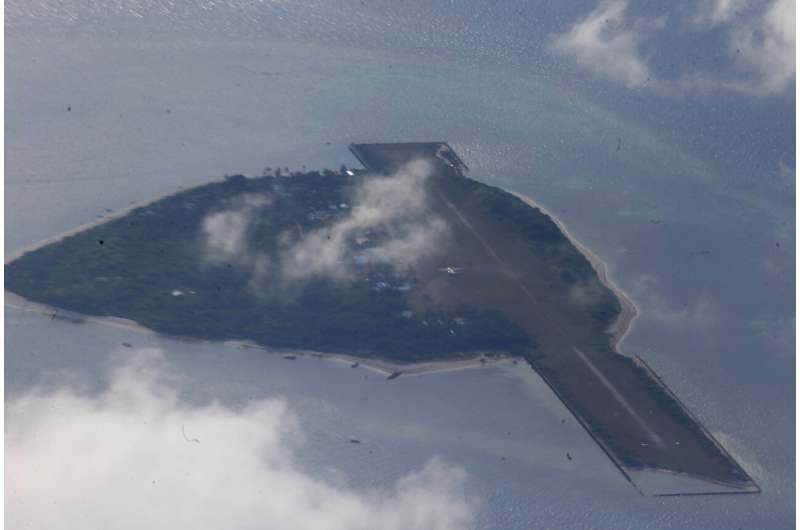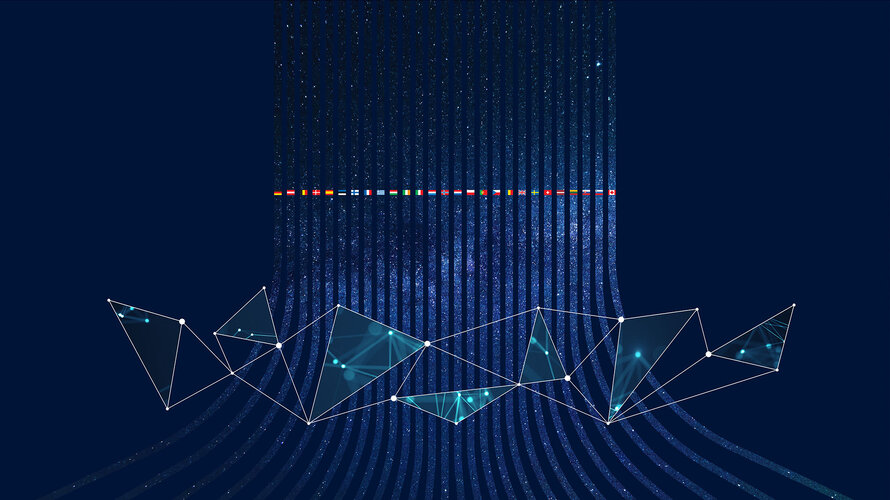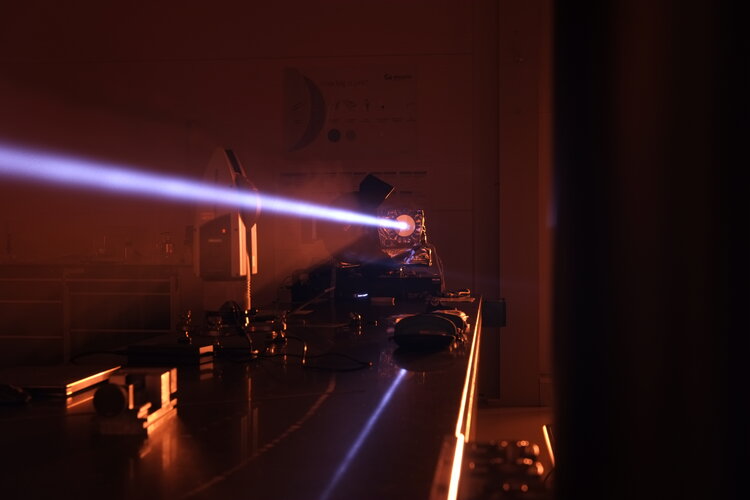
Copernical Team
Monday, 21 November 2022 08:15
Chinese coast guard seizes rocket debris from Filipino navy

Published in
News
Tagged under
Monday, 21 November 2022 09:01
Watch live: ESA Council Meeting at Ministerial Level

The ESA Council at Ministerial level (CM22) is taking place in Paris, France, on 22 and 23 November. ESA’s Member States, Associated States and Cooperating States will be invited to together strengthen Europe’s space ambitions and ensure that space continues to serve European citizens. Follow our live coverage of CM22 via ESA WebTV.
Published in
News
Tagged under
Monday, 21 November 2022 08:24
Hall of mirrors for Proba-3 laser testing
 Image:
Hall of mirrors for Proba-3 laser testing
Image:
Hall of mirrors for Proba-3 laser testing
Published in
News
Tagged under
Sunday, 20 November 2022 11:44
Solar snake spotted slithering across Sun's surface
Paris (ESA) Nov 15, 2022
 Solar Orbiter has spotted a 'tube' of cooler atmospheric gases snaking its way through the Sun's magnetic field. The observation provides an intriguing new addition to the zoo of features revealed by the ESA-led Solar Orbiter mission, especially since the snake was a precursor to a much larger eruption. The snake was seen on 5 September 2022, as Solar Orbiter was approaching the Sun for a close
Solar Orbiter has spotted a 'tube' of cooler atmospheric gases snaking its way through the Sun's magnetic field. The observation provides an intriguing new addition to the zoo of features revealed by the ESA-led Solar Orbiter mission, especially since the snake was a precursor to a much larger eruption. The snake was seen on 5 September 2022, as Solar Orbiter was approaching the Sun for a close
 Solar Orbiter has spotted a 'tube' of cooler atmospheric gases snaking its way through the Sun's magnetic field. The observation provides an intriguing new addition to the zoo of features revealed by the ESA-led Solar Orbiter mission, especially since the snake was a precursor to a much larger eruption. The snake was seen on 5 September 2022, as Solar Orbiter was approaching the Sun for a close
Solar Orbiter has spotted a 'tube' of cooler atmospheric gases snaking its way through the Sun's magnetic field. The observation provides an intriguing new addition to the zoo of features revealed by the ESA-led Solar Orbiter mission, especially since the snake was a precursor to a much larger eruption. The snake was seen on 5 September 2022, as Solar Orbiter was approaching the Sun for a close
Published in
News
Tagged under
Sunday, 20 November 2022 11:44
Rockets to uncover electric circuit that powers the Northern Lights
Andenes, Norway (SPX) Nov 17, 2022
 A NASA-funded rocket mission is headed to space to measure the global electric circuit underlying the northern lights. For its second trip to space, the Aurora Current and Electrodynamics Structures II, or ACES II, instrument will launch from Andoya Space in Andenes, Norway. The launch window opens Nov. 16, 2022, at 6 p.m. local time.
High above us, electrons from space stream into our sky
A NASA-funded rocket mission is headed to space to measure the global electric circuit underlying the northern lights. For its second trip to space, the Aurora Current and Electrodynamics Structures II, or ACES II, instrument will launch from Andoya Space in Andenes, Norway. The launch window opens Nov. 16, 2022, at 6 p.m. local time.
High above us, electrons from space stream into our sky
 A NASA-funded rocket mission is headed to space to measure the global electric circuit underlying the northern lights. For its second trip to space, the Aurora Current and Electrodynamics Structures II, or ACES II, instrument will launch from Andoya Space in Andenes, Norway. The launch window opens Nov. 16, 2022, at 6 p.m. local time.
High above us, electrons from space stream into our sky
A NASA-funded rocket mission is headed to space to measure the global electric circuit underlying the northern lights. For its second trip to space, the Aurora Current and Electrodynamics Structures II, or ACES II, instrument will launch from Andoya Space in Andenes, Norway. The launch window opens Nov. 16, 2022, at 6 p.m. local time.
High above us, electrons from space stream into our sky
Published in
News
Tagged under
Sunday, 20 November 2022 11:44
New observation method helps unlock secrets of UK meteorite
Ontario, Canada (SPX) Nov 17, 2022
 The Winchcombe meteorite, a rare carbonaceous meteorite which crashed onto a driveway in Gloucestershire in 2021, has been found to contain extra-terrestrial water and organic compounds that reveal insights into the origin of Earth's oceans. A new study, published by Science Advances, led by experts from the Natural History Museum and the University of Glasgow reports the orbital history and fir
The Winchcombe meteorite, a rare carbonaceous meteorite which crashed onto a driveway in Gloucestershire in 2021, has been found to contain extra-terrestrial water and organic compounds that reveal insights into the origin of Earth's oceans. A new study, published by Science Advances, led by experts from the Natural History Museum and the University of Glasgow reports the orbital history and fir
 The Winchcombe meteorite, a rare carbonaceous meteorite which crashed onto a driveway in Gloucestershire in 2021, has been found to contain extra-terrestrial water and organic compounds that reveal insights into the origin of Earth's oceans. A new study, published by Science Advances, led by experts from the Natural History Museum and the University of Glasgow reports the orbital history and fir
The Winchcombe meteorite, a rare carbonaceous meteorite which crashed onto a driveway in Gloucestershire in 2021, has been found to contain extra-terrestrial water and organic compounds that reveal insights into the origin of Earth's oceans. A new study, published by Science Advances, led by experts from the Natural History Museum and the University of Glasgow reports the orbital history and fir
Published in
News
Tagged under
Sunday, 20 November 2022 11:44
Jet engine installed on NASA's X-59
Edwards AFB CA (SPX) Nov 15, 2022
 NASA's quiet supersonic X-59 now has the engine that will power it in flight. The installation of the F414-GE-100 engine took place at Lockheed Martin's Skunk Works facility in Palmdale, California, earlier this month, marking a major milestone as the X-59 approaches the completion of its assembly.
The 13-foot-long engine from General Electric Aviation packs 22,000 pounds of propulsion ene
NASA's quiet supersonic X-59 now has the engine that will power it in flight. The installation of the F414-GE-100 engine took place at Lockheed Martin's Skunk Works facility in Palmdale, California, earlier this month, marking a major milestone as the X-59 approaches the completion of its assembly.
The 13-foot-long engine from General Electric Aviation packs 22,000 pounds of propulsion ene
 NASA's quiet supersonic X-59 now has the engine that will power it in flight. The installation of the F414-GE-100 engine took place at Lockheed Martin's Skunk Works facility in Palmdale, California, earlier this month, marking a major milestone as the X-59 approaches the completion of its assembly.
The 13-foot-long engine from General Electric Aviation packs 22,000 pounds of propulsion ene
NASA's quiet supersonic X-59 now has the engine that will power it in flight. The installation of the F414-GE-100 engine took place at Lockheed Martin's Skunk Works facility in Palmdale, California, earlier this month, marking a major milestone as the X-59 approaches the completion of its assembly.
The 13-foot-long engine from General Electric Aviation packs 22,000 pounds of propulsion ene
Published in
News
Tagged under
Sunday, 20 November 2022 11:44
Drug discovery and development - in space
Washington DC (SPX) Nov 18, 2022
 Carrying out scientific experiments in space allows scientists to study and make drugs without gravity, which can lead to surprising results that improve research back on Earth. According to a cover story in Chemical and Engineering News, an independent news outlet of the American Chemical Society, more commercial entities are expanding offerings in low-Earth orbit, which could someday enable mo
Carrying out scientific experiments in space allows scientists to study and make drugs without gravity, which can lead to surprising results that improve research back on Earth. According to a cover story in Chemical and Engineering News, an independent news outlet of the American Chemical Society, more commercial entities are expanding offerings in low-Earth orbit, which could someday enable mo
 Carrying out scientific experiments in space allows scientists to study and make drugs without gravity, which can lead to surprising results that improve research back on Earth. According to a cover story in Chemical and Engineering News, an independent news outlet of the American Chemical Society, more commercial entities are expanding offerings in low-Earth orbit, which could someday enable mo
Carrying out scientific experiments in space allows scientists to study and make drugs without gravity, which can lead to surprising results that improve research back on Earth. According to a cover story in Chemical and Engineering News, an independent news outlet of the American Chemical Society, more commercial entities are expanding offerings in low-Earth orbit, which could someday enable mo
Published in
News
Tagged under
Sunday, 20 November 2022 11:44
ispace Announces Mission 1 Launch Date
Tokyo, Japan (SPX) Nov 18, 2022
 ispace, inc., a global lunar exploration company, plans to launch its Mission 1 (M1) lunar lander, part of the HAKUTO-R lunar exploration program, on Nov. 28, 2022, at the earliest, on a SpaceX Falcon 9 rocket from Cape Canaveral Space Force Station, Founder and CEO Takeshi Hakamada announced at a press conference in Tokyo.
In addition to the launch date announcement, ispace unveiled 10 mi
ispace, inc., a global lunar exploration company, plans to launch its Mission 1 (M1) lunar lander, part of the HAKUTO-R lunar exploration program, on Nov. 28, 2022, at the earliest, on a SpaceX Falcon 9 rocket from Cape Canaveral Space Force Station, Founder and CEO Takeshi Hakamada announced at a press conference in Tokyo.
In addition to the launch date announcement, ispace unveiled 10 mi
 ispace, inc., a global lunar exploration company, plans to launch its Mission 1 (M1) lunar lander, part of the HAKUTO-R lunar exploration program, on Nov. 28, 2022, at the earliest, on a SpaceX Falcon 9 rocket from Cape Canaveral Space Force Station, Founder and CEO Takeshi Hakamada announced at a press conference in Tokyo.
In addition to the launch date announcement, ispace unveiled 10 mi
ispace, inc., a global lunar exploration company, plans to launch its Mission 1 (M1) lunar lander, part of the HAKUTO-R lunar exploration program, on Nov. 28, 2022, at the earliest, on a SpaceX Falcon 9 rocket from Cape Canaveral Space Force Station, Founder and CEO Takeshi Hakamada announced at a press conference in Tokyo.
In addition to the launch date announcement, ispace unveiled 10 mi
Published in
News
Tagged under
Sunday, 20 November 2022 11:44
iSpace reaches agreement with Mitsui Sumitomo to become first user of commercial lunar insurance
Tokyo, Japan (SPX) Nov 18, 2022
 Mitsui Sumitomo Insurance Co., Ltd. ("MSI"), a subsidiary of MS&AD Insurance Group Holdings, Inc. based in Tokyo, Japan, has reached an agreement with ispace, inc. (ispace), a global lunar exploration company, to provide the world's first "Lunar Insurance" policy that comprehensively covers risks arising from ispace's Mission 1, from the launch of the rocket to the lunar landing.
The agree
Mitsui Sumitomo Insurance Co., Ltd. ("MSI"), a subsidiary of MS&AD Insurance Group Holdings, Inc. based in Tokyo, Japan, has reached an agreement with ispace, inc. (ispace), a global lunar exploration company, to provide the world's first "Lunar Insurance" policy that comprehensively covers risks arising from ispace's Mission 1, from the launch of the rocket to the lunar landing.
The agree
 Mitsui Sumitomo Insurance Co., Ltd. ("MSI"), a subsidiary of MS&AD Insurance Group Holdings, Inc. based in Tokyo, Japan, has reached an agreement with ispace, inc. (ispace), a global lunar exploration company, to provide the world's first "Lunar Insurance" policy that comprehensively covers risks arising from ispace's Mission 1, from the launch of the rocket to the lunar landing.
The agree
Mitsui Sumitomo Insurance Co., Ltd. ("MSI"), a subsidiary of MS&AD Insurance Group Holdings, Inc. based in Tokyo, Japan, has reached an agreement with ispace, inc. (ispace), a global lunar exploration company, to provide the world's first "Lunar Insurance" policy that comprehensively covers risks arising from ispace's Mission 1, from the launch of the rocket to the lunar landing.
The agree
Published in
News
Tagged under

